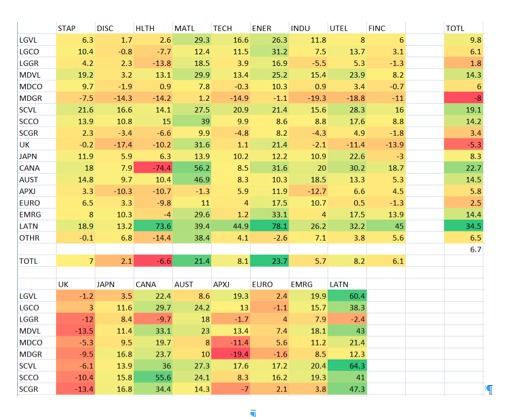By Mayuranki De, research analyst, Global X ETFs
Social Media & Blockchain
Seen as internet 3.0, Web3 reimagines internet services and mobile apps utilizing decentralized blockchain technology. Web3 seeks to leverage emerging technologies such as cryptocurrencies, non-fungible tokens (NFTs), gaming, augmented and virtual reality, and the metaverse. Like the metaverse, Web3 encourages companies to be interoperable and put ownership in the hands of users. The burgeoning digital land boom in the metaverse is a prime example of digital ownership. Consumers continue to invest in concert venues, shopping malls, and other high-demand properties using cryptocurrencies powered by the blockchain. Even the cheapest plots of land on two popular metaverse platforms, Sandbox and Decentraland, recently sold for more than $13,000 dollars.1
Electric Vehicles
EV Sales Surge Continues
Auto manufacturers continue to deliver on predictions of widespread electric vehicle (EV) adoption. In the latest available data, global EV sales for November 2021 were up 72% year-over-year and represented 11.5% of total vehicles sales.2 In Norway, which intends to be the first country to end sales of internal combustion engines, EVs accounted for nearly two-thirds of new car sales in 2021.3 Tesla was the top-selling brand in Norway, which helped the company sell a record 308,600 cars in the fourth quarter. Those sales pushed Tesla’s yearly total to 936,712, an 87% increase from 2020.4 With production at the company’s Berlin and Texas gigafactories slated to start in 2022, Tesla’s momentum could continue. Even companies that joined the EV race later intend to aggressively ramp up their EV production. For example, Toyota intends to produce 3.5 million EVs and develop 30 battery-powered models by 2030.5
Fintech
BNPL Becoming a Banking Staple
Forty-two percent of survey participants in the U.S. said that they planned to use buy now, pay later (BNPL) platforms for at least a portion of their 2021 holiday spending.6 Thirty-two percent noted a willingness to spend $99, while 26% said that they would go as high as $200.7 Like BNPL’s success in the U.S., the Chinese market has significant potential given its consumers’ penchant for online shopping coupled with its established mobile payments ecosystem. For 2021, BNPL is expected to grow 51.3% to $82.78 billion.8 BNPL’s growth has the attention of the major credit rating agencies. Historically, BNPL lending had no effect on consumer credit history. However, Experian, TransUnion, and Equifax are working to create credit reports on BNPL loans, giving consumers another opportunity to build and improve their FICO scores.
U.S. Infrastructure
Step One: Ports
Following the passage of the Infrastructure and Investment Jobs Act (IIJA), investment in the country’s port facilities is underway. In December, Transportation Secretary Pete Buttigieg announced $241 million in discretionary grant funding for 25 new projects in 19 states and one territory to help smooth the ongoing supply chain issues.9 Under the IIJA, this grant will nearly double each year for the next five years.10 Not only are these investments aimed at easing supply chain issues, but they should also provide jobs.
Internet of Things
Japan Enters the Chip Race
The U.S. and China along with Taiwan and South Korea are the main players in the increasingly competitive global semiconductor market. However, a notable competitor is Japan. The government announced that it wants to triple the country’s domestic chip revenue by 2030 and is investing $6.8 billion towards that goal.11 In 2021, chip shortages created significant supply chain issues for top Japanese companies such as Toyota, Sony Group, and Keyence. Examples of potential long-term solutions to shortages like these include the government’s recent approval for Taiwan Semiconductor Manufacturing Co. to build a $7 billion chip plant with Sony Group.12
Cannabis
Europe Moves to Legalize
In December, Malta became the first country in the European Union to officially legalize cannabis for recreational use. Maltese residents will be permitted to carry up to seven grams of cannabis and grow up to four plants in their residences.13 With this new law, the Maltese government hopes to end the criminalization of cannabis and reduce criminal trafficking. Following Malta’s lead, Germany is preparing to legalize cannabis for recreational use by allowing sales to adults in licensed shops. Other nations are expected to follow suit. Luxemburg moved to legalize cannabis for personal use in October 2021 but was delayed by the pandemic. Also, Italy set a referendum to decriminalize domestic cannabis growth and possession.
This post first appeared on January 18 on the Global X ETF blog.
Photo Credit: phsymyst via Flickr Creative Commons
References
1. Fortune, “The cheapest plots on popular metaverse platforms are already selling for more than $13,000”, Jan 5, 2022.
2. Seeking Alpha, “EV Company News For The Month Of December 2021”, Jan. 3, 2022.
3. Reuters,” Electric cars hit 65% of Norway sales as Tesla grabs overall pole”, Jan. 5, 2022.
4. CNBC, “Tesla delivered 936,172 electric vehicles in 2021, with the fourth-quarter setting a new record”, Jan. 2, 2022.
5. New York Times, “Toyota, lagging rivals, outlines plans to expand sales of electric vehicles.”, Dec. 14, 2021.
6. PYMNTS.com, “BNPL Expected to Play an Expanding Role in 2021 Holiday Spending”, Dec. 30, 2021.
7. Ibid.
8. CNBC, “China’s ‘buy now, pay later’ market is growing — but challenges remain”, Dec. 16, 2021.
9. Reuters, “U.S. transportation secretary announces over $241 mln in grants for U.S. ports”, Dec. 23, 2021.
10. WJHL.com, “Buttigieg doles out $241M to US ports to boost supply chain”, Dec. 23, 2021.
11. Bloomberg, “Japan Has Big Plans For Chips”, Jan. 4, 2022.
12. Reuters, “Taiwan govt OKs Taiwan Semiconductor’s new chip plant in Japan”, Dec. 20, 2021.
13. New York Times, “Malta Becomes First E.U. Country to Legalize Marijuana”, Dec. 15, 2021.
DISCLOSURE
Investing involves risk, including the possible loss of principal. There is no guarantee the strategies discussed will be successful. International investments may involve risk of capital loss from unfavorable fluctuation in currency values, from differences in generally accepted accounting principles or from economic or political instability in other nations. Emerging markets involve heightened risks related to the same factors as well as increased volatility and lower trading volume. Narrowly focused investments may be subject to higher volatility. The funds are non-diversified.
Information Technology companies can be affected by rapid product obsolescence, and intense industry competition. Risks include disruption in service caused by hardware or software failure; interruptions or delays in service by third-parties; security breaches involving certain private, sensitive, proprietary and confidential information managed and transmitted; and privacy concerns and laws, evolving Internet regulation and other foreign or domestic regulations that may limit or otherwise affect the operations. Healthcare, Genomics, Biotechnology and Medical Device companies can be affected by government regulations, expiring patents, rapid product obsolescence, and intense industry competition.
Investments in infrastructure-related companies have greater exposure to the potential adverse economic, regulatory, political and other changes affecting such entities. Investment in infrastructure-related companies are subject to various risks including governmental regulations, high interest costs associated with capital construction programs, costs associated with compliance and changes in environmental regulation, economic slowdown and excess capacity, competition from other providers of services and other factors.
Investments in blockchain companies may be subject to the following risks: the technology is new and many of its uses may be untested; theft, loss or destruction of key(s) to access the blockchain; intense competition and rapid product obsolescence; cybersecurity incidents; lack of liquid markets; slow adoption rates; lack of regulation; third party product defects or vulnerabilities; reliance on the Internet; and line of business risk. Blockchain technology may never develop optimized transactional processes that lead to realized economic returns for any company in which the Funds invest.



